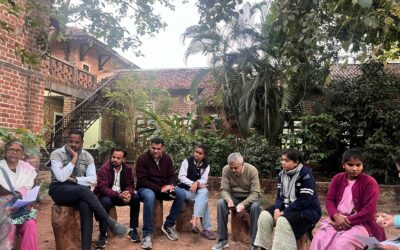“The roots below the earth claim no rewards for making the branches fruitful.”
Rabindranath Tagore
As a Bengali far from home, October felt especially bittersweet this year. The Durga Puja season brought vivid memories of festive streets, dhunuchi naach, and the aroma of bhog, leaving me longing for Kolkata’s vibrancy. But something remarkable unfolded when I visited the only Durga Puja pandal in Bhuj, where i am placed as a fellow. What began as a simple attempt to feel less homesick turned into an insightful exploration of the Bengali community’s transformative journey in this westernmost corner of India.
From Goldsmiths To Entrepreneurs
The Bengali diaspora primarily comprises of two distinct groups: the Ghotis, natives of West Bengal, and the Bangals, who migrated to India from Bangladesh during the tumultuous decades of the 1950s to 1970s. Historically, Bangals were economically disadvantaged compared to Ghotis, who often possessed generational wealth. Surprisingly, the dynamics in Bhuj appear inverted. Both communities, united by their shared Bengali identity, arrived in Bhuj roughly three decades ago as migrant laborers, mainly in the gold designing industry.
Over the years, while many continue to work as skilled laborers, some have carved a niche for themselves as business owners, transforming their socio-economic landscape. Unlike their Gujarati counterparts, who have advanced into diamond scrapping and other lucrative industries, these Bengali entrepreneurs have largely retained their focus on the gold business. This sector remains a crucial thread binding their history and livelihood, reflecting both resilience and adaptability. The story of Bengalis in Bhuj doesn’t end with the gold and diamond industries.
A New Wave Of Migration

West Bengal’s ongoing unemployment crisis has pushed a new wave of migrants—young, educated professionals—toward Bhuj and other cities in Gujarat. Take Soumya, my colleague and friend at Hunnarshala Foundation, an exceptionally talented architect who left the east coast in search of better opportunities. Stories like his resonate deeply with me; they underscore the relentless pursuit of growth and stability that drives Bengalis westward.
This wave of migration is creating a ripple effect, drawing in students and interns seeking meaningful experiences. One such individual is Soumak, an architect intern at Hunarshala, who was inspired by stories of professionals like Soumya. For students like Soumak, Bhuj has become a hub of learning and growth, where seasoned professionals act as magnets, attracting young talent eager to contribute and learn in a dynamic environment. This evolving ecosystem reflects not just a professional shift but also a cultural exchange that enriches both Bhuj and its Bengali community.
The Transition In A Nutshell
The transformation of the Bengali community in Bhuj can be broken down into distinct stages, influenced by various socio-economic factors and personal aspirations. Here’s a concise overview:
- 1990s–2000s: Survival And Adaptation
- Primary Activity: Migrant labourers arrived to work in gold designing factories, driven by limited economic opportunities in West Bengal and Bangladesh.
- Key Influencers:
- Economic Need: Poverty and unemployment in their hometowns.
- Skill Utilization: Leveraging their artisanal expertise to find stability.
- Community Bonding: A shared cultural identity helped them adapt to the new environment.
- 2000s to Present: Growth And Entrepreneurship
- Primary Activity: Transitioning from labor to small-scale entrepreneurship, with some individuals starting their own gold-related businesses.
- Key Influencers:
- Experience: Years of working in gold factories provided the technical know-how.
- Economic Opportunities: Access to better earnings and reinvestment in business.
- Cultural Connection: Remaining rooted in gold craftsmanship despite the local Gujarati expansion into diamond scrapping.
- 2010s to Present: Emergence Of Professionals
- Primary Activity: Migration of educated professionals, including architects, engineers, and students, seeking employment in Bhuj’s growing industries.
- Key Influencers:
- Economic Crisis: Unemployment and underemployment in West Bengal prompted migration.
- Networking Effect: Professionals like Soumya attract younger talent, such as interns like Soumak, fostering a supportive ecosystem.
- Cultural Integration: A blend of Bengali heritage and local opportunities enriches the community fabric.
Overarching Variables Driving Transformation
“You can’t cross the sea merely by standing and staring at the water.”
Rabindranath Tagore
The Bengali community in Bhuj has transitioned through survival, growth, and professional expansion. As they redefine their identity in a new land, they demonstrate resilience and unity, forming a tribe that connects deeply across generations and professions. And for someone like me, far from home, being amidst this transformation feels like finding a new way to belong—a comforting tribe in an unexpected place.
The Bengali community in Bhuj has undergone a remarkable transformation over the decades, evolving from a group of migrant labourers to a dynamic part of the city’s socio-economic fabric. Their journey reflects resilience, unity, and a drive to bridge the gap between tradition and progress.
While many continue to work in the gold and diamond industries, others have carved out successful ventures, bringing a touch of Bengali enterprise and culture to this westernmost part of India.
In Image: With my co-fellow Kavyamshi (another Bengali who has grown up across the country, recently in the north east) is also working here

The Journey Ahead
As I walked away from the pandal that night, my heart was filled with admiration for this community. Their journey—from migrant labourers to thriving entrepreneurs and skilled professionals—is a testament to their resilience and adaptability. It’s a story of transformation not just in their economic standing but also in their sense of identity.
For me, as someone far from home, standing under the starry skies of Bhuj during Durga Puja, surrounded by the rhythmic beats of the dhaak and the warmth of this close-knit community, I found something profound. Home isn’t always a place. It’s a feeling you carry within, woven together by the shared stories and struggles of people who resonate with your roots. And while away from my own home, I am getting to know these people and a new way to find myself a comforting tribe.




0 Comments